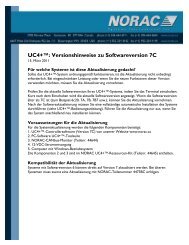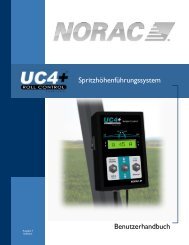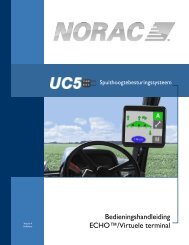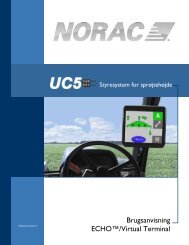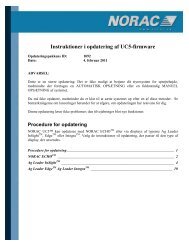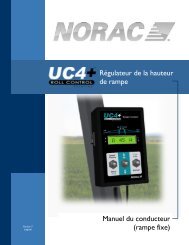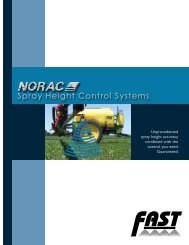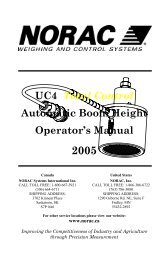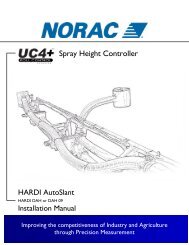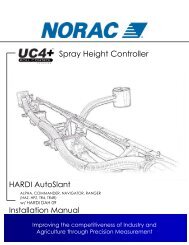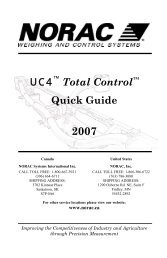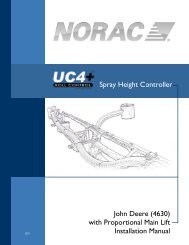UC4™ Total Control™ Automatic Boom Height Technical ... - Norac
UC4™ Total Control™ Automatic Boom Height Technical ... - Norac
UC4™ Total Control™ Automatic Boom Height Technical ... - Norac
Create successful ePaper yourself
Turn your PDF publications into a flip-book with our unique Google optimized e-Paper software.
6.1.5 Sensing Further Ahead of the <strong>Boom</strong><br />
Installing the sensor farther ahead of the boom is not an acceptable solution<br />
to any performance issues. The reason is that, as the sensor is moved<br />
further ahead, there will be an increasing height error at the nozzles. In<br />
other words, the sensor and nozzle are at two different points in space, thus<br />
introducing an error for all but the most level terrain. In severe terrain, this<br />
height error can bring the nozzles close to the ground as the sensor reads<br />
over the crest of a hill, or down into a ditch.<br />
6.1.6 Sensor Capabilities<br />
In order for the UC4 system to work at its maximum level of performance,<br />
the UC4 sensors must be returning accurate height readings at the designed<br />
frequency. Under typical conditions, the sensors can provide accurate<br />
height readings from 9 inches to over 120 inches, and return many height<br />
readings in one second. The target in SOIL mode can be identified through<br />
stubble, young crops, row crops, and normal trash. The target in CROP<br />
mode can be identified over cereal grains, specialty crops, and row crops.<br />
See the next section for more information on CROP and SOIL mode<br />
guidelines<br />
There are two main steps to ensure sensor performance. The first step is<br />
proper mounting. See Section 4.2 on page 5 for more information on<br />
sensor mounting. The second step is to ensure that the protective foam<br />
covers on the sensors are kept clean, and that the ultrasonic transducer<br />
behind the foam does not become corroded or excessively dirty. Extra<br />
foams are shipped with your kit. The transducer is a maintenance item and<br />
can be replaced at NORAC service locations. Transducers can last from<br />
three to ten years, depending on conditions. Refer to Section 9 on page 48<br />
and the UC4 Quick Guide for more maintenance information.<br />
If the mouth of the sensor becomes wet, it is normal for the sensor to return<br />
error messages until the transducer has dried off. This could include rain or<br />
excessive overspray. Material can build up on the transducer if the sensor is<br />
mounted too close to the spray nozzles. This is the reason that the sensor<br />
must be mounted at least 9 inches in front of the nozzles. It keeps the<br />
sensor housing out of the normal region of overspray.<br />
In the sprayer boom application, the sensors ignore any target that is closer<br />
than 9 inches from the bottom of the sensor housing. This region is called<br />
the blanking range. Operating the sensor at heights near the blanking range<br />
is dangerous and will affect performance because height readings can be<br />
very intermittent. This is the reason that each sensor must be mounted at<br />
least 9 inches above the spray nozzles.<br />
18



